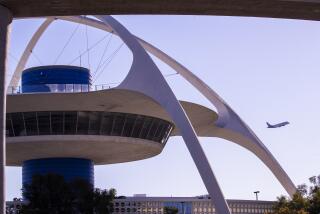FAA to Order Tighter Control of Small Planes
- Share via
WASHINGTON — Spurred by the Aug. 31 collision over Cerritos, the Federal Aviation Administration announced Monday that it plans to tighten control of small planes that fly near the nation’s 23 busiest airports, including Los Angeles International.
The proposals are among 40 recommendations FAA Administrator Donald D. Engen approved after a special agency task force conducted a monthlong examination of “terminal control areas” surrounding the Los Angeles airport and those in most other major U.S. cities.
Simplified Design
A key proposal would establish one simplified, standard design for the terminal control areas at all 23 airports. Standardized control areas would make it easier for pilots to navigate near busy airports, especially unfamiliar ones, agency officials said.
The new plan calls for a uniform circular configuration of about 30 miles surrounding the airports that would extend vertically to 10,000 feet. The dimensions of terminal control areas now vary from airport to airport.
In Los Angeles, for example, the terminal area consists of 12 wedge-shaped layers that extend outward to about 30 miles east and west of the airport, and about 12 miles to the north and south. In contrast, the area surrounding National Airport and Andrews Air Force Base in Washington, D.C., has a radius of about 15 miles and resembles a three-dimensional figure-eight.
Regional FAA Administrator Homer C. McClure in Los Angeles said the agency is considering realigning the boundaries of the control area with prominent landmarks, such as major highways.
Another major recommendation disclosed Monday would require that all private planes flying into these restricted areas carry altitude-encoding devices called “Mode C transponders,” which emit signals that report altitude to air traffic controllers. Private pilots flying into Los Angeles and eight other U.S. airports already are required to have these devices. The FAA plan would expand the requirement to 14 additional airports, which now require less sophisticated equipment.
No Urgency Seen
However, McClure said he believes that there is no need to make immediate changes in aviation regulations or procedures in Southern California. Moreover, he and Engen agreed that none of the proposals disclosed Monday necessarily would have prevented the collision over Cerritos.
“The aviation system in this region as well as in this nation is the safest system in the world and we intend to keep it that way,” McClure said. “If it needs changing, we’re going to change it.”
Any redrawing of control area boundaries and the other proposals made public Monday are subject to federal rule-making procedures. If any ultimately are approved, they will not take effect for at least a year, Engen said. He added that each recommendation will be given careful consideration “to make sure that the changes we do adopt are genuine improvements for the flying public.”
The FAA has come under intense scrutiny in recent weeks by both pilots and the general public in the wake of the Cerritos crash. Within days of the collision, Engen created the in-house task force to review all 23 terminal control areas, while McClure established a similar group to specifically review the Los Angeles control area.
Accident Killed 82
The disaster occurred when an Aeromexico DC-9 collided with a single-engine Piper Archer that had entered the terminal control area without permission. Eighty-two people were killed, including 15 on the ground. The Archer had a transponder, but it was not of the Mode C variety, said the National Transportation Safety Board.
Terminal control areas were established in the 1970s in an attempt to prevent air collisions between aircraft. Pilots must first contact controllers before entering the areas and must have transponders on board.
The FAA announcement drew support from some segments of the aviation community.
William F. Bolger, president of the Air Transportation Assn., which represents the major U.S. airlines, said his group supports the FAA’s “strong actions to assure air safety in terminal control areas.”
Senior Vice President Ed Pinto of the 260,000-member Aircraft Owners and Pilots Assn., said the organization welcomes a simplification of the nation’s terminal control areas. But Pinto expressed reservations about the call for more transponders, saying the FAA’s computers will not be able for several years to keep track of all the aircraft that would be required to use altitude-indicating transponders.
Viewpoint of Pilots
AOPA officials and others have argued that some pilots cannot afford transponders, while other pilots, particularly those in rural areas, do not need them.
About 75% of all general aviation aircraft have transponders, according to the FAA, and about half of those planes have the altitude-encoding devices. Virtually all commercial aircraft are equipped with transponders.
The FAA recommendations also call for increased pilot training and stepped up enforcement actions, including a mandatory, minimum 60-day license suspension for pilots who violate terminal control areas.
In addition to the one surrounding Los Angeles International, control areas are located around major airports at Atlanta, Boston, Chicago, Dallas, Miami, New York, San Francisco, Washington, Cleveland, Denver, Detroit, Honolulu, Houston, Kansas City, Las Vegas, Minneapolis, New Orleans, Philadelphia, Pittsburgh, Seattle, St. Louis and San Diego.
Last year, there were a total of 20 to 30 enforcement actions initiated against pilots who violated control areas around those airports. By comparison, there are 25 such actions now under way in the Los Angeles area alone.
Peggy Pagano reported from Washington, David Freed from Los Angeles.
More to Read
Sign up for Essential California
The most important California stories and recommendations in your inbox every morning.
You may occasionally receive promotional content from the Los Angeles Times.










